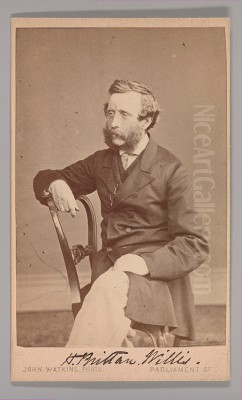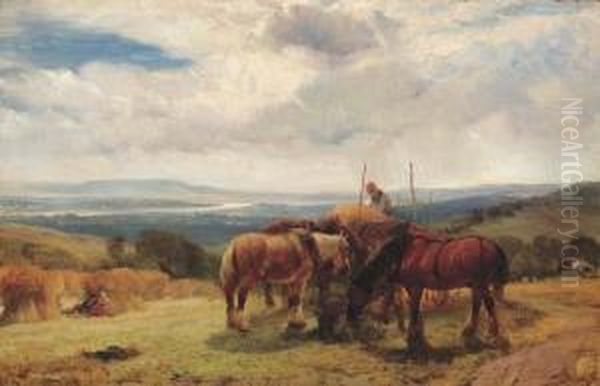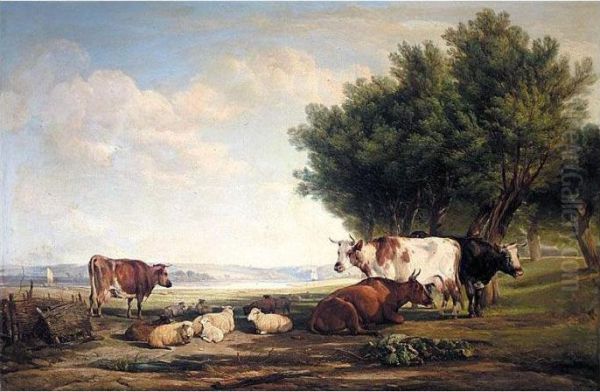
Henry Brittan Willis, a notable figure in the landscape of 19th-century British art, dedicated his career to capturing the serene beauty and agrarian charm of the English countryside. As a painter proficient in both oils and watercolours, he specialized in landscapes and animal subjects, leaving behind a body of work that continues to be appreciated for its meticulous detail, tranquil atmosphere, and faithful representation of rural existence. His life, spanning from 1810 to 1884, coincided with a period of immense change in Britain, yet his art remained a steadfast homage to the enduring pastoral ideal.
Early Life and Artistic Formation
Born in Bristol in 1810, Henry Brittan Willis was immersed in art from a young age. His primary artistic instruction came from his father, G. H. Willis, who was himself a painter. This early familial tutelage likely provided a strong foundation in the fundamental techniques of drawing and painting. Bristol, a bustling port city with a rich cultural heritage, would have offered a stimulating environment for a budding artist, though the specifics of his early artistic activities in the city are not extensively documented.
Seeking broader opportunities and a more prominent artistic stage, Willis eventually made the pivotal decision to relocate to London. The capital was the undeniable center of the British art world, offering access to prestigious academies, influential patrons, and a vibrant community of fellow artists. It was in London that Willis would establish his professional career and cultivate his reputation as a skilled painter of the natural world.
The Development of a Distinctive Style
Willis's artistic style is characterized by its remarkable finesse, calmness, and precision. He possessed a keen observational ability, which he translated into highly detailed and naturalistic depictions of landscapes and, particularly, farm animals. His works often evoke a sense of peacefulness and order, reflecting an idealized vision of rural life that resonated with Victorian sensibilities. The clarity and meticulousness of his brushwork were notable, allowing him to render the textures of animal hides, the foliage of trees, and the nuances of light and shadow with considerable skill.

Art critics and historians have often compared the brightness and precision in Willis's paintings to those of his contemporaries, such as William Shayer (1788-1879), known for his rustic scenes and depictions of gypsy encampments and coastal life, and Thomas Creswick (1811-1869), a popular landscape painter admired for his charming views of English and Welsh scenery. Like these artists, Willis catered to a public that appreciated well-crafted, accessible representations of the British landscape, a genre that held enduring appeal throughout the 19th century. His ability to capture the specific character of the English countryside, with its rolling hills, verdant fields, and gentle waterways, was a hallmark of his oeuvre.
Thematic Focus: The English Countryside and its Inhabitants
The primary subjects of Henry Brittan Willis's art were the landscapes of rural England and the animals that populated them. He demonstrated a particular fondness and aptitude for painting cattle and sheep, often depicting them grazing peacefully in sun-dappled fields or resting by tranquil streams. These pastoral scenes were not merely picturesque; they also conveyed a sense of harmony between humanity, animals, and the land. In an era of rapid industrialization and urbanization, such images offered a comforting reminder of a seemingly simpler, more traditional way of life.
His compositions are typically well-balanced, with careful attention paid to the interplay of light and atmosphere. Whether working in oil or watercolour, Willis managed to imbue his scenes with a gentle luminosity. His animal figures are rendered with anatomical accuracy and a sympathetic understanding of their nature, avoiding overt sentimentality while still capturing their quiet dignity. Works such as his numerous studies of cattle in meadows or by riverbanks exemplify his dedication to this specific niche within landscape and animal painting.
Masterworks and Notable Paintings
Among Henry Brittan Willis's most representative and celebrated works are paintings like Harvest Horses and Cattle in a Field. These titles themselves suggest his deep engagement with agrarian themes. Harvest Horses likely depicted the powerful draft animals central to agricultural labor, perhaps shown during the busy harvest season, a subject rich with connotations of productivity and the cyclical rhythms of nature. Cattle in a Field would have showcased his skill in rendering these animals in their natural environment, emphasizing their calm presence within the landscape.

These paintings, and others like them, are characterized by their detailed execution and serene mood. They reflect the Victorian appreciation for both the picturesque qualities of the countryside and the perceived virtues of rural life. While specific details about the creation dates of all his works are not always readily available, pieces like Harvest Horses and Cattle in a Field are known to be held in private collections, including one located in Gloucestershire, UK, attesting to their enduring value among collectors of British art. The meticulous finish and tranquil beauty of such paintings solidified Willis's reputation during his lifetime.
Professional Affiliations and Recognition
To further his career and gain wider exposure, Henry Brittan Willis actively participated in the London art scene. He became a member of the prestigious Society of Painters in Water Colours, often referred to as the "Old Watercolour Society." Membership in this society was a significant mark of distinction for watercolourists, as it was the leading institution dedicated to promoting and exhibiting works in this medium. His involvement suggests a high level of proficiency and recognition for his watercolour paintings.
Furthermore, Willis regularly exhibited his works at prominent venues, including the Royal Academy of Arts. The Royal Academy's annual summer exhibition was, and remains, a crucial platform for artists to display their talents and attract critical attention and patronage. He was also associated with the "Free Exhibition" society, an alternative exhibiting body that provided artists with more autonomy in showcasing their work. These affiliations underscore his active engagement with the professional art world and his efforts to ensure his paintings reached a discerning audience. His consistent presence in these exhibitions helped to build his reputation and secure his place among the respected landscape and animal painters of his day.
Artistic Collaborations
While primarily known for his independent work, Henry Brittan Willis did, on occasion, collaborate with other artists. One such documented collaboration was with Frederick Hulme (1816-1884), a fellow landscape painter who was also known for his work as an engraver and illustrator. Hulme contributed illustrations to publications such as the Art Journal, a highly influential periodical that played a significant role in shaping Victorian taste and disseminating art criticism.
The nature of such collaborations could vary; sometimes one artist might paint the landscape while another added figures or animals, or they might work jointly on a single composition. For Willis, whose specialty was animals and landscapes, collaborating with an artist like Hulme, who also had a strong grounding in landscape and a connection to the print market, could have been mutually beneficial. These collaborations, though perhaps infrequent, highlight the interconnectedness of the Victorian art world, where artists often shared studios, participated in the same societies, and sometimes joined forces on specific projects. This collaborative spirit, even if not a dominant feature of Willis's career, reflects a common practice within the artistic community of the time.
A Career Interrupted: The Devastating Fire of 1873
A significant and tragic event in Henry Brittan Willis's life was a devastating fire that occurred in January 1873. This conflagration reportedly destroyed a substantial portion of his artistic output, representing some thirty years of his labor. Among the works said to have been lost were pieces titled or similar to Cattle and Sheep in a Landscape and Harvest Horses. Such a loss would have been a profound blow to any artist, representing not only a financial setback but also the destruction of irreplaceable creative endeavors.
The exact location of this fire and the full extent of the damage are details that underscore the precariousness of an artist's legacy, especially before modern archival and conservation practices became widespread. For Willis, this event must have been a deeply personal and professional crisis. Recovering from such a loss would have required immense resilience. Despite this calamity, Willis continued to paint and exhibit, suggesting a determined spirit and an unwavering commitment to his art. This incident, however, adds a poignant chapter to his biography, reminding us of the tangible vulnerability of artistic creations.
Willis and His Contemporaries: A Comparative Perspective
To fully appreciate Henry Brittan Willis's contribution, it is useful to consider him within the broader context of Victorian art and his contemporaries. In the realm of animal painting, Sir Edwin Landseer (1802-1873) was an towering figure, renowned for his dramatic and often anthropomorphic depictions of animals, particularly stags and dogs. While Willis shared Landseer's interest in animals, his approach was generally more tranquil and less narrative-driven. Another key contemporary specializing in similar subject matter was Thomas Sidney Cooper (1803-1902), who became exceptionally famous for his paintings of cattle and sheep, often set in idyllic Kentish landscapes. Cooper's meticulous realism and pastoral charm bear some resemblance to Willis's own work, and both artists catered to a strong public demand for such scenes.
In landscape painting, the towering figures of John Constable (1776-1837) and J.M.W. Turner (1775-1851) had, by Willis's active period, already revolutionized the genre, emphasizing direct observation of nature and expressive use of paint. While Willis's style was perhaps less revolutionary, he operated within a tradition that valued careful rendering and the depiction of specific locales. Other Victorian landscape painters like Benjamin Williams Leader (1831-1923) achieved immense popularity with their detailed and often expansive views of the British countryside. In the field of watercolour, artists like Myles Birket Foster (1825-1899), known for his charming and highly detailed rustic scenes, and Helen Allingham (1848-1926), celebrated for her depictions of picturesque cottages and gardens, also contributed to the rich tapestry of Victorian landscape art.
It is also important to distinguish Willis from artists associated with more radical movements of the time, such as the Pre-Raphaelite Brotherhood. Figures like Dante Gabriel Rossetti (1828-1882), John Everett Millais (1829-1896), and William Holman Hunt (1827-1910) sought to reform art by rejecting what they saw as the overly academic and mannered approach of their predecessors, drawing inspiration from early Renaissance art. The artist Henry Wallis (1830-1916), sometimes confused with Henry Brittan Willis due to the similarity in names, was associated with the Pre-Raphaelite circle and is famous for works like The Death of Chatterton and The Stonebreaker, which possess a dramatic intensity and social commentary quite different from Willis's pastoral scenes. Another artist with Pre-Raphaelite links, Ford Madox Brown (1821-1893), also explored historical and social themes with a distinctive realism. Willis's art, by contrast, remained firmly rooted in the established traditions of landscape and animal painting, offering a vision of rural England that was both idealized and meticulously observed.
The Victorian Art World: A Fertile Ground
The Victorian era, during which Henry Brittan Willis flourished, was a period of extraordinary artistic activity and public interest in art. The growth of industrial wealth created a new class of patrons eager to acquire paintings, and art became increasingly accessible to the middle classes through public exhibitions and the proliferation of engraved reproductions. The Royal Academy exhibitions were major social events, and art criticism in journals and newspapers fueled public debate and shaped artistic reputations.
Landscape and animal painting were particularly popular genres. The British landscape, with its varied scenery and deep cultural associations, was a source of national pride. Animal painting, especially of domestic and farm animals, resonated with a society that, despite increasing urbanization, retained strong connections to its agricultural roots. Artists like Willis, who could skillfully and appealingly render these subjects, found a ready market for their work. The demand for art that was both realistic and morally uplifting, or at least pleasantly evocative, was a defining characteristic of the Victorian art market. Willis's tranquil and well-ordered scenes fit well within these prevailing tastes.
Later Career and Enduring Legacy
Despite the setback of the 1873 fire, Henry Brittan Willis continued his artistic practice into his later years. He remained committed to his chosen subjects, producing landscapes and animal studies that upheld the standards of quality and charm for which he was known. He passed away in 1884, in his native city of Bristol, the same place where his life and artistic journey had begun.
Henry Brittan Willis's legacy lies in his contribution to the rich tradition of British landscape and animal painting. While perhaps not an innovator on the scale of a Turner or a Constable, he was a highly accomplished and respected artist who excelled in his particular niche. His paintings offer a valuable visual record of the 19th-century English countryside, filtered through a sensibility that prized tranquility, order, and meticulous craftsmanship. His works continue to be sought after by collectors and are represented in various public and private collections, serving as a testament to his skill and the enduring appeal of his pastoral vision. He remains a notable example of the many talented artists who contributed to the vibrancy and diversity of the Victorian art world.
Conclusion
Henry Brittan Willis carved out a distinguished career as a painter of the English rural scene. His dedication to capturing the gentle beauty of the landscape and the quiet dignity of its animal inhabitants resulted in a body of work that is both aesthetically pleasing and historically significant. As a member of the Old Watercolour Society and a regular exhibitor at the Royal Academy, he was an active participant in the artistic life of his time. His paintings, characterized by their fine detail, serene atmosphere, and precise execution, offer a window into a vision of pastoral England that held great appeal for his Victorian contemporaries and continues to charm viewers today. Through his art, Willis provided a lasting chronicle of a world that, even in his own time, was undergoing profound transformation, securing his place as a skilled and sensitive observer of nature's enduring grace.